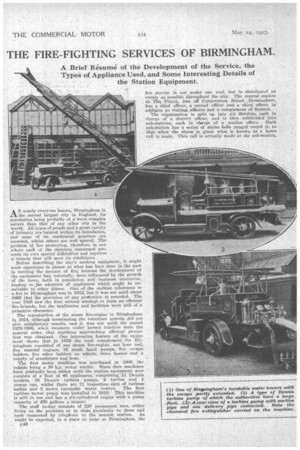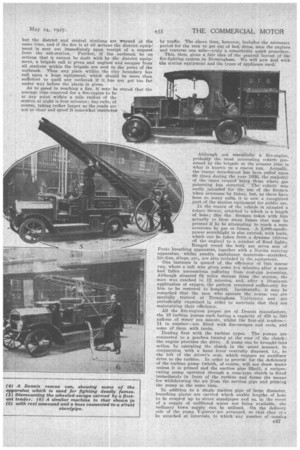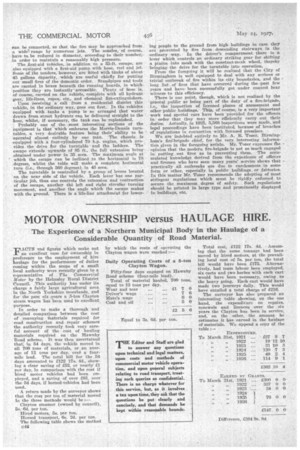THE FIRE-FIGHTING SERVICES OF BIRMINGHAM.
Page 104

Page 105

Page 106

If you've noticed an error in this article please click here to report it so we can fix it.
A Brief R6sume of the Development of the Service, the Types of Appliance Used, and Some Interesting Details of the Station Equipment.
...ti A S nearly everyone knows, Birmingham is
the second largest city in England, its population being probably of a more complex nature than that of any other city in the world. All types of people and a great variety of industry are located within its boundaries, and some of its residential quarters are crowded, whilst others are well spaced. The problem of fire protection, therefore, is one where each of the districts concerned presents its own special difficulties and requires a remedy that will meet its conditions.
Before describing the city's modern equipment, it might seem opportune to glance at what has been done in the past in meeting the menace of fire, because the development of the equipment has, naturally, been influenced by the growth of the town, both' in population and business enterprise, leading to the adoption of appliances which might be unsuitable to other places. One of the earliest references to a fire in Birmingham was in 1612, but it was not until about -,1695 that lie provision of any protection is recorded. The year 1805 saw the first serious attempt to form an efficient ,fire-brigade, but the appliances and facilities were still of a primitive character.
The introduction of the steam fire-engine in Birmingham in 1874, although terminating the volunteer system, did not give satisfactory results, and it was not until the period 1879-1906, when steamers under horsed traction were the general order, that anything approaching efficient proteotion was obtained. One interesting feature of the equipment shows that in 1879 the total complement for Birmingham consisted of one steam fire-engine, one hose reel, five manual engines, 15 small hand pumps, five escape ladders, five other ladders on wheels, three horses and a supply of standpipes and hose.
The first motor machine was purchased in 1906, the vehicle being a 30 h.p. motor tender. Since then machines have gradually been added until the station equipment now consists of a fleet of 46 appliances, comprising 11 Dennis tenders, 19 Dennis turbine pumps, 2 lorries and 1 rescue van, whilst there are 11 inspection cars of various makes and 2 motor turntable water towers. The first turbine motor pump was installed in 1910. This machine is still in use and has a six-eylindered engine with a pump capacity of 450 gallons a minute.
The staff to-day consists of 220 permanent men, either living on the premises or in close proximity to them and each connected by telephone to the nearest station. As might" be expected, in a place so large as Birmingham, the fire service is not under one roof, but is distributed as evenly as possible throughout the city. The central station • at: Thq Priory, just off Corporation Street, ,Birmingham, has a chief officer, a second officer and a third officer, in addition .0 visiting:officers and a compleinent of firemen.
The organization is split up into six districts, each in charge of a district officer, and is then anbdivided into • sub-stations, each in charge of a station officer. Each sub-station has a series of alarm bells ranged round it, so that when the alarm is given what is known as a home call is made. This call is actually made at the sub-station, but the district and central stations are warned at the same time, and if the fire is at all serious the district equip= meat is sent out immediately upon receipt of a request from the sub-station. Further, if the outbreak be so serious that it cannot he dealt with by the district equip= ment, a brigade call is given and engines and escapes from all stations within the brigade are sent to the point of the outbreak. Thus any place within the city boundary has call upon a huge equipment, which should be more than sufficient to Quell any outbreak if it has not got too far under way before the alarm is given.
As to speed in reaching a fire, it may be stated that the average time required for a fire-engine to be at any point within a mile radius of the station at night is fonr minutes ; day calls, of course, taking rather longer as the roads are not so clear and speed IS some-What restricted
by traffic. The above time, however, includes the necessary period for the men to get out of bed, dress, man the engines and traverse one mile—truly a remarkably quick procedure.
This, then, gives a fair idea of the general layout of the fire-fighting system in Birmingham. We will now deal with the ststion equipment and the types of appliance used: -Although not essentially a fire-engine, probably' the Most interesting vehicle possessed by the brigade at the present time is what is known as a rescue van. Actually, the -rescue detachment has been called. upon 60 :times during the year 1926, theajOrity of the eases treated being those Where gas poisoning has Occurred. The vehicle was really intended for the use' of the firemen when overcome by finites, but, as there have been so many calls., it is now a recognized. part of the station equipment for public use.
In the centre of the vehicle is situated a rotary blower, attached to which is a length of hose; this the fireman takes with him actually to blow away fumes that may be present if he be attempting to reach a man overcome by gas or fumes. A 2,000-candlepower searchlight is also carried, with leads, which can be taken from a dynamo (driven off the engine) to a number of flood lights.
Ranged round the body are seven sets of Proto breathing apparatus, together with a Novita reviving apparatus, whilst sundry ambulance materials—stretcher, life-line, slings, etc., are also included in the equipment.
One instance is quoted of the efficiency' of this rescue van, where a call was given.some ten minutes after a man had 'fallen unconscious suffering from coal-gas poisoning. Although situated 0 miles distant from the station, the man was reached in 12 minutes, and, after a 10-minute application of oxygen, the patient recovered sufficiently for him to be removed to hospital. Incidentally, it may be remarked that the men who operate the rescue van are specially trained at Birmingham University and are perio.dically examined in order to ascertain that they are maintaining their efficiency.
All the -fire-engines proper are of Dennis manufacture, the 19 turbine pumps each having a capacity of 450 to 500 makes of water per minute, whilst the first-aid tenders11 in number—are fitted with fire-escapes and reels, and some of them with tanks. •
Dealing first with the turbine types. The pumps are connected to a gearbox located at the rear of the clutch ; the engine provides the drive. A pump can he brought into action by operating the clutch in the usual manner, in conjunction with a hand lever centrally disposed, i.e., to the left of the driver's seat, which engages an auxiliary drive to the turbine. In order to provide for the deficiency of the turbine pump (which, of course, will not draw water unless it is primed and the suction pipe filled), a reciprocating pump operated through a cone-type clutch is fitted immediately in front of the turbine and forms the means for withdrawing the ai.r from the suction pipe and priming, the pump at the same time.
In addition to it single suction pipe of large diameter, breeching Pieces are carried which enable lengths of hose to be coupled up to street standpipes and so, in the event of a supply of unfiltered water not being available, the ordinary town supply can be utilized. On the delivery side of the pump Y-pieces are arranged,to that 01.1; be attached at intervals, to which 'any number of •
can be connected, so that the fire may be approached from a wide'' range by numerous jets. The nozzles, of course, have to be reduced in diameter, according to their number, in order to maintain a reasonably high pressure.
The ,first-aid vehicles,, in addition to a 55-ft. escape, are also equipped with a first-aid pump with hose, reel and jet. Sonic of the tenders, however, are fitted with tanks of about 45 gallons capacity, which' are useful chiefly for putting out small fires of the domestic order. Standpipes and tools are carried in boxes beneath the running boards, in which 'position they are instantly accessible. Plenty of hose is, of course, carried on the vehicle, complete with all hydrant gear, life-lines, ropes, etc., and chemical fire-extinguishers.
Upon receiving a call from a residential district this vehicle, in the ordinary way, goes out first. In the vehicles equipped with tanks a pump is so arranged that water drawn from street hydrants can be delivered straight to the hose, whilst, if necessary, the tank ,can be replenished.
Probably one of the most interesting sections of the equipment is that which embraces the Morris-Dennis turntables, a very desirable feature being their' abilityto be operated almost entirely by one man. The chassis is equipped with a fotrr-cylindered 70 h.p. engine, which provides the drive for the turntable and the ladders. The escape extends upwards of 85 ft., the full extension being obtained under power in 35 sect. The maximum angle at ' which the escape can be inclined to the horizontal is 78 degrees, whilst the table will make a complete horizontal .turn (i.e., through 360 degrees) in 45 secs.
The turntable is controlled by a group of levers located on the near side of the vehicle. Each lever has one particular job, thus one controls the extension and contraction of the escape, another the left and right circular turning movement, and another the angle which the escape makee with the ground. There is a life-line attachment for lower
ing people to the ground from high buildings in case they are prevented by fire from descending stairways in the ordinary way. In the driver's compartment there is a lever which controls an ordinary striking gear for shifting a pinion into mesh with the constant-mesh wheel, thereby bringing the drive for the turntable into operation.
From the foregoing it will be realized that the City of Birmingham is well equipped to deal with any serious or trivial outbreak of fire within its city boundaries, and the long list of fires that have occurred during the past few years and have been successfully got under control bear witness to this efficiency.
There is one point, though, which is not realized by the general public as being part of the duty of a fire-brigade, i.e., the inspection of licensed places of amusement and other public buildings. This, of course, is a very important work and special cars have been provided for the officers in order that they may more efficiently carry out their duties. Actually, in 1925, 5,568 inspections were made,, and legal proceedings have been instituted because of breaches of regulations in connection with licensed premises.
We are indebted entirely to Mr. A. R. Tozer, Birmingham's fireThrigade chief, for the very interesting information given in the foregoing article. Mr. Tozer expresses the opinion that the modern fire-brigade is not so much engaged in putting out fires as in preventing them. The accumulated kntewledge derived from the experience of officers and firemen who have seen many years' service shows that practically all outbreaks are due to carelessness in some form or other, especially in public buildings or factories. In this matter Mr. Tozer recommends the adoption of most stringent regulations which must be rigidly enforced to secure the maximum degree of safety. Such regulations should be printed in large type and prominently displayed in buildings, etc.




















































































































































































